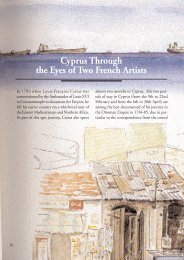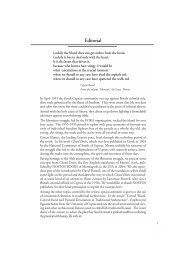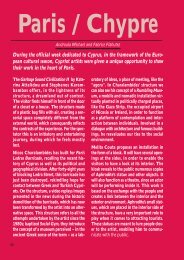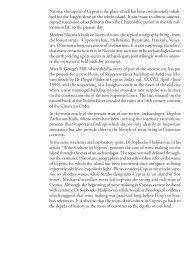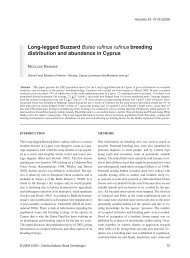Editorial
Editorial
Editorial
Create successful ePaper yourself
Turn your PDF publications into a flip-book with our unique Google optimized e-Paper software.
Homer called it “golden liquid”.<br />
"The olive tree heard the plough and thought<br />
it was the irrigation ditch." The reason why<br />
the olive oil of Kythrea was famous is because<br />
in Kythrea there was a perennial spring, the<br />
largest spring on the island, which watered<br />
many olive trees and turned 32 watermills<br />
(Xioutas, A, 1984, 114, no. 346, 297, no.<br />
1055, 32, no. 84, and Xioutas, B, 1985, 155,<br />
no. 253).<br />
The tree also needed skilful pruning, which<br />
was most important for a good yield: "The<br />
olive tree needs a crazy pruner and a sensible<br />
picker," that is to say merciless pruning and<br />
prudent harvesting, with the hands (Xioutas,<br />
B, 1985, 20 no. 1955). In proverbial speech,<br />
the olive tree voices all its needs: "The olive<br />
tree tells its owner: Dig round me? You remember<br />
me. Manure me? You feed me. Water me?<br />
I am refreshed. Prune me? You make me pregnant."<br />
(Xioutas,C, 1985, 266, no. 4947).<br />
Crucial for production is the flowering season<br />
in the spring, when the fruit is small<br />
and tender. Being unable to control the weath-<br />
er conditions, people resorted to religion and<br />
superstition. They believed that "When you<br />
say ‘Christ is risen’ to the olive trees on Easter<br />
morning, they keep their fruit" (Xioutas, A,<br />
1984, 77, no. 221).<br />
For the olive tree to develop it needs air and<br />
light, not buildings all around it: "The olive<br />
tree heard the builder’s trowel and burst into<br />
tears" (Xioutas, A, 1984, 32-33, no. 85).<br />
The periodical production of the olive tree<br />
also passed into proverbs. The tree was<br />
considered an independent lady who produced<br />
fruit when she wanted to: "They invited<br />
the olive tree to the wedding and it told<br />
them a lady doesn’t go" (Xioutas, A, 1984,<br />
351-352, no. 1283).<br />
The harvesting of the fruit began in August<br />
with the picking of the green olives which<br />
would become tsakkistes (crushed). They left<br />
the other olives to turn black and these they<br />
picked in October and even November. The<br />
men climbed up the trees and shook the branches<br />
so that the fruit would fall and be picked<br />
up by the other members of the family or<br />
female labourers, but the final harvesting at<br />
the beginning of the winter was done by striking<br />
the tree with vakles (long sticks) or long<br />
canes. This very ancient method was effective<br />
but harmful to the tree and was strongly<br />
criticised by the British (see the relevant comment<br />
in the consular report of 1844 in<br />
Papadopoullos 1980, 20).<br />
A certain amount of the olives was salted to<br />
keep for food for the whole year, while the<br />
main crop from the ladoelies ("oil olives") was<br />
to be turned into oil. From 3-5 okes of<br />
olives they produced an oke of oil. They put<br />
the olives into big baskets of 40 okes. Before<br />
they took them to the mill, they spread<br />
them out in their yards or on the flat roof tops<br />
7





